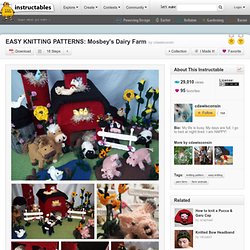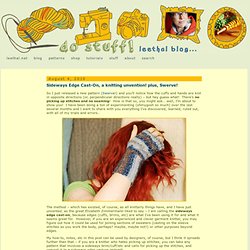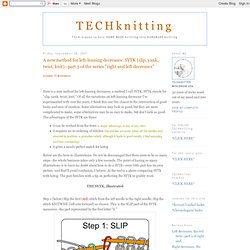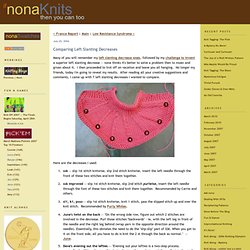

EASY KNITTING PATTERNS: Mosbey's Dairy Farm. When I was in the sixth grade, I took a beginning knitting class.

We learned to make a hat and mine turned out to be a total disaster. I just recently decided to try knitting again and had to refresh my memory by reading every How To Instructable I could find. For many pieces of the farm, I have documented the pattern I created. The patterns are very, very basic. I know that I will make every vetran knitter cringe and I offer an apology at the get-go, but like I said, I am just learning. Mosbey's Farm is in honor of my new home state, Wisconsin. Thank you for looking. Knit and Crochet 1. Sideways Edge Cast-On, a knitting unvention! plus, Swerve! So I just released a new pattern (Swerve!)

And you’ll notice how the cuffs and hands are knit in opposite directions (or, perpendicular directions really) – but hey guess what! There’s no picking up stitches and no seaming! How is that so, you might ask… well, I’m about to show you! I have been doing a ton of experimenting (ohmygosh so much) over the last several months and I want to share with you everything I’ve discovered, learned, ruled out, with all of my trials and errors… The method – which has existed, of course, as all knitterly things have, and I have just unvented, as the great Elizabeth Zimmermann liked to say – I am calling the sideways edge cast-on, because edges (cuffs, brims, etc) are what I’ve been using it for and what it seems great for.
Below is an example of a version of the method having been worked as a hat brim. Now, what was up with that “ratio of stitches to rows” issue mentioned above? Cast-on 6 stitches.Knit 1 row.Purl 1 row.Kfb, place marker, k to end. Ravelry and knitting: Why Facebook can't match the social network for knitters. - By Farhad Manjoo. The best social network you've (probably) never heard of is one-five-hundredth the size of Facebook. It has no video chat feature, it doesn't let you check in to your favorite restaurant, and there are no games. The company that runs it has just four employees, one of whom is responsible for programming the entire operation.
It has never taken any venture capital money and has no plans to go public. Despite these apparent shortcomings, the site's members absolutely adore it. They consider it a key part of their social lives, and they use it to forge deeper connections with strangers—and share more about themselves—than you're likely to see elsewhere online. Ravelry's success is evidence in favor of an argument that you often hear from Facebook's critics: A single giant social network is no fun.
Ravelry was created in 2007 by Casey and Jessica Forbes, a husband-and-wife team in Boston. The way Ravelry took off from there is a gripping yarn. Knitting in Color. Curlicues are underutilized in knitting.

They are so simple and can really spark up a bland project. Imagine a plain old knitted hat. Now imagine the same hat topped with a dozen curlicues in different colors and lengths. Much more fun! Nicky Epstein also suggests using curlicues for fringe but she calls them corkscrews. I make my curlicues slightly differently than she does. These curlicues were made with worsted weight yarn and size 8 (US) needles. Knit into the front and back of each stitch loosely, ending up with 40 stitches. Take your finished curlicue and twist it in the direction it is already curling. A new method for left-leaning decreases: SYTK (slip, yank, twist, knit)
Includes 10 illustrations Here is a new method for left-leaning decreases, a method I call SYTK.

SYTK stands for "slip, yank, twist, knit. " Of all the variations on left-leaning decreases I've experimented with over the years, I think this one lies closest to the intersection of good looks and ease of creation. Some alternatives may look as good, but they are more complicated to make, some alternatives may be as easy to make, but don't look as good. The advantages of the SYTK are these:it can be worked from the front (a major advantage, to me, at any rate) it requires no re-ordering of stitches (the stitches are never taken off the needles and reversed in position--a procedure which, although it leads to good results, I find annoying and time consuming). it gives a nearly perfect match for k2togBelow are the how-to illustrations. Do not be discouraged that there seem to be so many steps--the whole business takes only a few seconds.
Comparing Left Slanting Decreases. « France Report | Main | Low Resistance Syndrome » July 20, 2006 Comparing Left Slanting Decreases Many of you will remember my left slanting decrease woes, followed by my challenge to invent a superior left slanting decrease -- nona thinks it's better to solve a problem then to moan and groan about it.

I then proceeded to trot off on vacation and leave you all hanging.